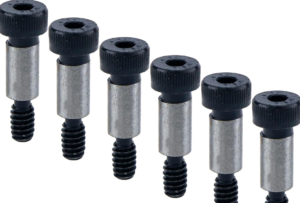
Maintaining machinery in top condition is crucial for ensuring efficiency, minimizing downtime, and reducing the need for costly repairs. Preventative measures, including the use of high-quality components and specialized coatings, can significantly extend the lifespan of your machines. Below are some strategies to protect your machinery and avoid unnecessary repairs.
Shoulder Bolts: Ensuring Proper Alignment and Load Distribution
One essential component in machinery maintenance is the use of Shoulder Bolts. These bolts are designed to provide proper alignment and load distribution for moving parts, making them a critical component in machinery that undergoes repetitive motion. Shoulder bolts are engineered with a smooth, cylindrical shoulder that allows for rotation or linear motion while preventing undue friction. By using the correct shoulder bolts and replacing worn ones promptly, you can ensure that your machinery operates smoothly, reducing the risk of misalignment and unnecessary wear on other components.
Industrial Liquid Coatings: Protecting Against Corrosion and Wear
Another vital protection measure for machinery involves the application of industrial liquid coatings. These coatings serve as a protective barrier against harsh environments, preventing rust, corrosion, and wear caused environmental factors such as moisture, chemicals, and abrasion. For machines operating in wet or corrosive environments, the use of industrial coatings is essential. Liquid coatings are applied to metal surfaces, providing an extra layer of protection and extending the life of machinery. Regular inspections and reapplications of these coatings can help prevent surface degradation and reduce the need for extensive repairs.
Regular Lubrication: Keeping Parts Running Smoothly
One of the most effective ways to protect machinery is to ensure that all moving parts are properly lubricated. Lack of lubrication can cause parts to grind against each other, leading to excessive wear and potential failure. Regularly applying high-quality lubricants to bearings, gears, and other moving components can significantly reduce friction, extend the lifespan of the parts, and decrease the likelihood of breakdowns. Developing a routine lubrication schedule based on manufacturer recommendations is essential for keeping machinery in optimal condition.
Monitoring Vibration and Temperature Levels
Excessive vibration and temperature fluctuations are common indicators of potential machinery problems. Using vibration and temperature monitoring systems can help detect issues early, allowing for preventative action before costly repairs are needed. Vibration sensors can detect imbalances or misalignments, while temperature sensors monitor overheating. Addressing these issues promptly can prevent further damage and ensure that machinery continues to run efficiently without requiring major repairs.
Regular Inspections and Maintenance
Routine inspections and preventive maintenance are key strategies for avoiding unnecessary repairs. Setting up a regular maintenance schedule based on the machine’s usage, operating conditions, and manufacturer recommendations helps to identify issues before they become severe. Inspections should include checking for signs of wear on belts, seals, and bearings, as well as ensuring that all systems are functioning correctly. By staying on top of routine maintenance tasks such as cleaning, tightening, and replacing worn components, you can avoid unexpected breakdowns and expensive repairs.
Corrective Action on Overloading
Overloading machinery is one of the fastest ways to cause excessive wear and tear. When machines are pushed beyond their specified capacity, components are forced to work harder, resulting in premature failure. To prevent this, always ensure that machinery is used within its designed load limits. Using overload protection systems, such as automatic shutoff mechanisms or alarms, can help prevent damage caused overloading. Training operators to recognize the importance of adhering to weight limits and load specifications is also a key factor in maintaining equipment longevity.
Invest in High-Quality Spare Parts
Using high-quality, OEM (original equipment manufacturer) parts instead of cheaper, generic alternatives can make a significant difference in the longevity and reliability of your machinery. Although high-quality parts may have a higher initial cost, they offer superior performance and durability, ultimately saving you money in the long run reducing repair needs and machine downtime. Always ensure that the parts you replace meet the manufacturer’s specifications to maintain the integrity of your machinery.
Proper Machine Storage
When machinery is not in use, proper storage is essential to prevent deterioration. Exposure to extreme temperatures, humidity, or dust can lead to rust, corrosion, and the degradation of seals, bearings, and other components. Storing machines in clean, dry, and temperature-controlled environments, when possible, can protect them from environmental damage. Additionally, ensuring that machines are properly covered or enclosed can prevent debris from entering sensitive areas, which could lead to costly repairs.
Conclusion
Protecting machinery from unnecessary repairs requires a combination of good practices, quality materials, and regular maintenance. By using the right components like shoulder bolts, applying industrial liquid coatings to prevent corrosion, lubricating moving parts, and following other protective measures, you can significantly extend the lifespan of your machinery. Regular inspections, adherence to load limits, and proper storage practices are also crucial in maintaining machine health. These preventative measures not only save money on repairs but also improve the overall efficiency and reliability of your machinery.
